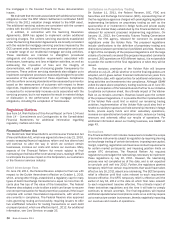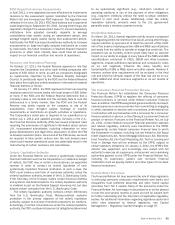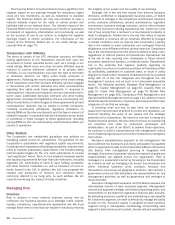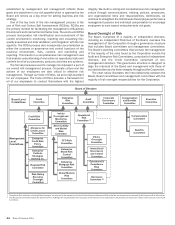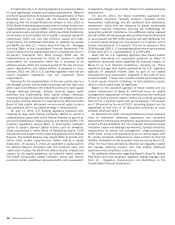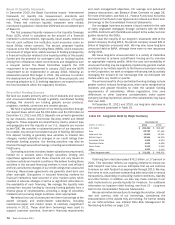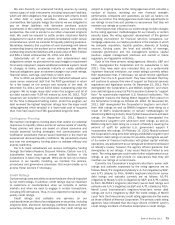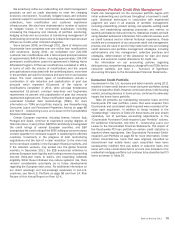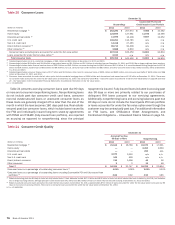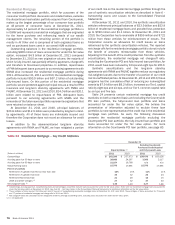Bank of America 2011 Annual Report Download - page 70
Download and view the complete annual report
Please find page 70 of the 2011 Bank of America annual report below. You can navigate through the pages in the report by either clicking on the pages listed below, or by using the keyword search tool below to find specific information within the annual report.68 Bank of America 2011
If implemented by U.S. banking regulators as proposed, Basel
III could significantly increase our capital requirements. Basel III
and the Financial Reform Act propose the disqualification of Trust
Securities from Tier 1 capital, with the Financial Reform Act
proposing that the disqualification be phased in from 2013 to
2015. Basel III also proposes the deduction of certain assets from
capital (deferred tax assets, MSRs, investments in financial firms
and pension assets, among others, within prescribed limitations),
the inclusion of accumulated OCI in capital, increased capital for
counterparty credit risk, and new minimum capital and buffer
requirements. For additional information on deferred tax assets
and MSRs, see Note 21 – Income Taxes and Note 25 – Mortgage
Servicing Rights to the Consolidated Financial Statements. The
phase-in period for the capital deductions is proposed to occur in
20 percent increments from 2014 through 2018 with full
implementation by December 31, 2018. An increase in capital
requirements for counterparty credit risk is proposed to be
effective January 2013. The phase-in period for the new minimum
capital requirements and related buffers is proposed to occur
between 2013 and 2019. U.S. banking regulators have not yet
issued proposed regulations that will implement these
requirements.
Preparing for the implementation of the new capital rules is a
top strategic priority, and we expect to comply with the final rules
when issued and effective. We intend to continue to build capital
through retaining earnings, actively reducing legacy asset
portfolios and implementing other capital related initiatives,
including focusing on reducing both higher risk-weighted assets
and assets currently deducted, or expected to be deducted under
Basel III, from capital. We expect non-core asset sales to play a
less prominent role in our capital strategy in future periods.
On June 17, 2011, U.S. banking regulators proposed rules
requiring all large bank holding companies (BHCs) to submit a
comprehensive capital plan to the Federal Reserve as part of an
annual Comprehensive Capital Analysis and Review (CCAR). The
proposed regulations require BHCs to demonstrate adequate
capital to support planned capital actions, such as dividends,
share repurchases or other forms of distributing capital. CCAR
submissions are subject to the review and approval of the Federal
Reserve. The Federal Reserve may require BHCs to provide prior
notice under certain circumstances before making a capital
distribution. On January 5, 2012, we submitted a capital plan to
the Federal Reserve consistent with the proposed rules. The
capital plan includes the ICAAP and related results, analysis and
support for the capital guidelines, and planned capital actions.
The ICAAP incorporates capital forecasts, stress test results,
economic capital, qualitative risk assessments and assessment
of regulatory changes, all of which influence the capital adequacy
assessment.
On July 19, 2011, the Basel Committee published the
consultative document “Globally systemic important banks:
Assessment methodology and the additional loss absorbency
requirement” which sets out measures for global, systemically
important financial institutions including the methodology for
measuring systemic importance, the additional capital required
(the SIFI buffer), and the arrangements by which they will be phased
in. As proposed, the SIFI buffer would be met with additional Tier
1 common equity ranging from one percent to 2.5 percent, and in
certain circumstances, 3.5 percent. This will be phased in from
2016 through 2018. U.S. banking regulators have not yet provided
similar rules for U.S. implementation of a SIFI buffer.
Given that the U.S. regulatory agencies have issued neither
proposed rulemaking nor supervisory guidance on Basel III,
significant uncertainty exists regarding the eventual impacts of
Basel III on U.S. financial institutions, including us. These
regulatory changes also require approval by the U.S. regulatory
agencies of analytical models used as part of our capital
measurement and assessment, especially in the case of more
complex models. If these more complex models are not approved,
it could require financial institutions to hold additional capital,
which in some cases could be significant.
Based on the assumed approval of these models and our
current assessment of Basel III, continued focus on capital
management, expectations of future performance and continued
efforts to build a fortress balance sheet, we currently anticipate
that our Tier 1 common equity ratio will be between 7.25 percent
and 7.50 percent by the end of 2012, assuming phase-in per the
regulations at that time of all deductions scheduled to occur
between 2013 and 2019.
On December 20, 2011, the Federal Reserve issued proposed
rules to implement enhanced supervisory and prudential
requirements and the early remediation requirements established
under the Financial Reform Act. The enhanced standards include
risk-based capital and leverage requirements, liquidity standards,
requirements for overall risk management, single-counterparty
credit limits, stress test requirements and a debt-to-equity limit
for certain companies determined to pose a threat to financial
stability. Comments on the proposed rules are due by March 31,
2012. The final rules are likely to influence our regulatory capital
and liquidity planning process, and may impose additional
operational and compliance costs on us.
For additional information regarding Basel II, Basel III, Market
Risk Rules and other proposed regulatory capital changes, see
Note 18 – Regulatory Requirements and Restrictions to the
Consolidated Financial Statements.




